18 Things to Do in Ozurgeti – Explore Guria’s Capital
The capital of Guria, Ozurgeti, is a quiet town that, much like the whole region, often flies under the radar of mainstream tourism. Known for its rich history, tea production, Soviet architecture, vibrant street art, and stunning landscapes around it, Ozurgeti is one of the perfect starting points for your Gurian adventure. This guide covers the top things to do in Ozurgeti city, goes beyond its town borders, and includes more sights within the municipality.
I spent some of my childhood in Guria as my father is from a village in Chokhatauri Municiaplity. As a child, I didn’t really like my time there, but as an adult, I started to appreciate the region as it has quite an interesting history, beautiful scenery, and cultural festivals, to name a few. I have written a separate Guria guide, covering its history in-depth and exploring more sights.
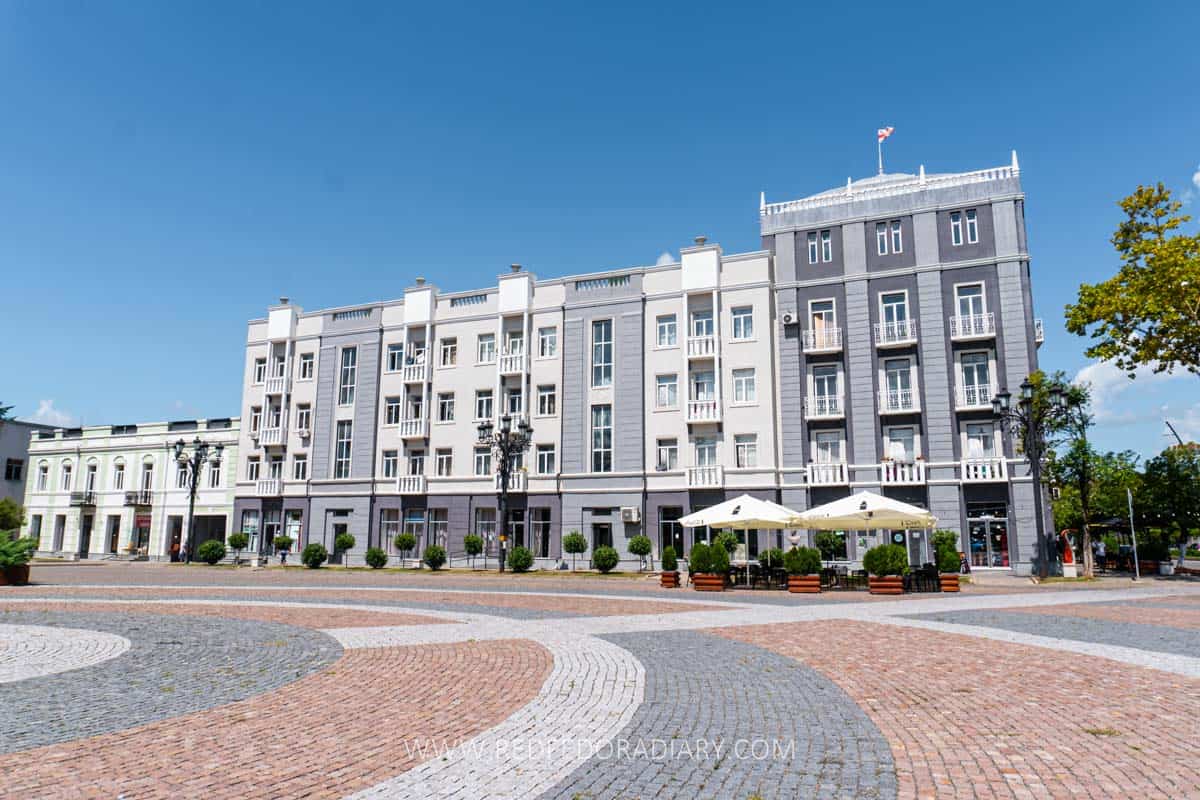
I have visited Ozurgeti a few times for short trips and have seen a change between those visits. However, don’t expect it to be as lively as Kutaisi or Telavi. In my opinion, it’s similar to Zugdidi and Gori.
The city is very walkable, with its sights concentrated around the center. There are a few parks to sit down and relax between the walks. Compared to Chokhatauri, the tourist infrastructure is more developed, but the city still needs more guesthouses or hotels, at least on platforms such as Booking.com. Most charming, cozy, and unique accommodation options, such as stays at wineries, tea plantations, or A-Frame cabins, are concentrated in nearby villages.
The city has many shops, chain grocery and electronic shops, a bustling food and clothing market, an impressive museum, an art gallery, a dozen beautiful street art, gorgeous Soviet architecture, and restaurants.
My Travel Essentials
Get an eVisa: Check if you need one at iVisa and fill out the form to get your eVisa easily.
Book a flight: I use Skyscanner or WayAway. The latter offers cashback with a Plus membership.
Airport transfers: Avoid the hassle of public transport and pre-book a transfer with Gotrip.
Reserve a hotel: My go-to platform for hotels or apartments is Booking.com.
Wine tours: Eat This! Tours offer premium wine tours. Use code RFD5 to get 5% OFF.
Hiking & culture tours: WT Georgia is the best for unique trips. Email them Red Fedora & get 10% OFF.
Find best-suited tours: For other tours, entrance tickets, and activities, I use Viator or Get Your Guide.
Rent a car: With affordable prices, Local Rent is one of the best car rental platforms.
Hire a driver: GoTrip is ideal for long-distance private transfers at very reasonable prices.
Debit card: I have Wise (an alternative to Revolut) for local money withdrawals without hidden fees or high exchange rates.
eSIM: To avoid heavy roaming fees, use Airalo or Saily. Compare prices and GB packages. Use BAIA2592 on Airalo and BAIAIR6152 on Saily to get 3 USD on both.
Travel insurance: SafetyWing covers health insurance and has add-ons for adventure sports and electronics theft coverage.
Disclaimer: Some of the links in this post are affiliate links, which means I may earn a small commission if you buy something through them—at no extra cost to you. It helps support my blog and lets me share real, first-hand travel tips. Learn more
Why visit Ozurgeti
Ozurgeti, founded in the late Middle Ages, soon became the center of Guria and an essential hub for trade. It was also home to the rulers of the Principality of Guria, created during the division of a unified kingdom of Georgia in the late 15th century. Twenty-two princes of the House of Gurieli ruled the principality from the 1460s to 1829.
The principality’s borders fluctuated during permanent conflicts with neighboring Georgian rulers and the Ottoman Empire, and the area enjoyed various degrees of autonomy until it was annexed by Imperial Russia in 1828.
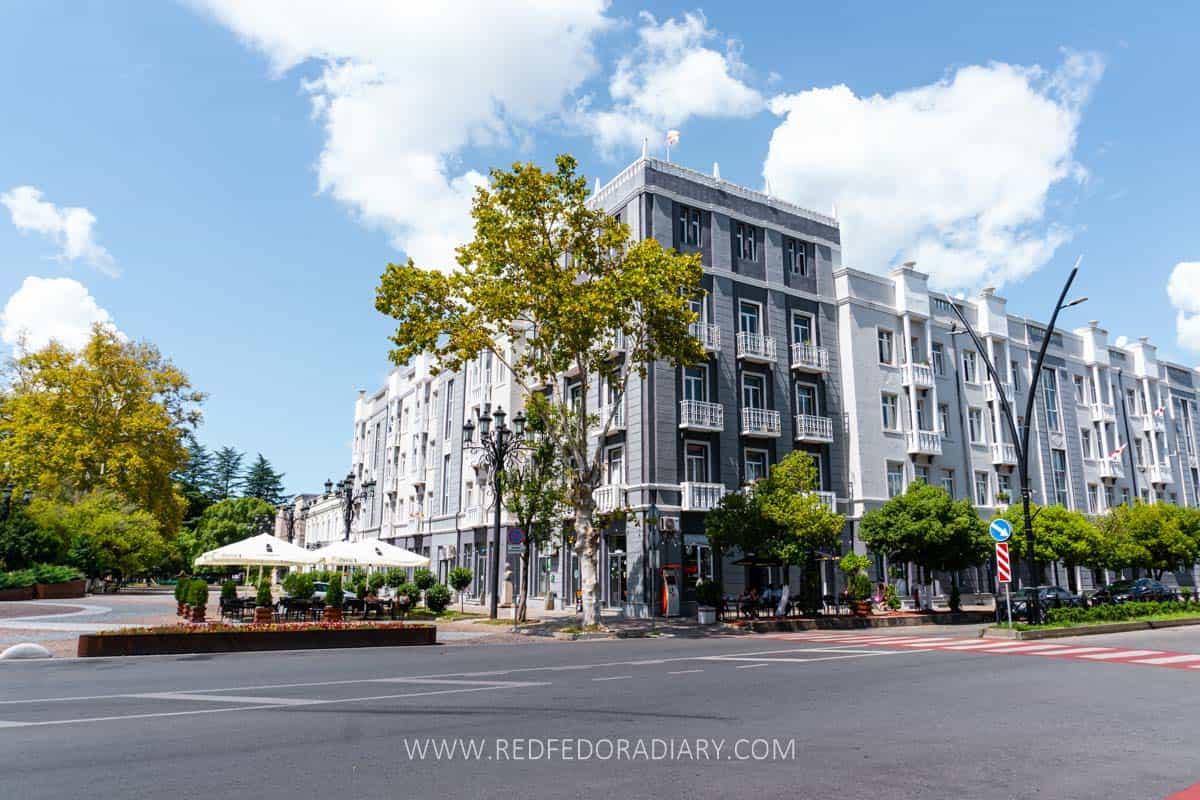
During the Russian Empire, the city was the administrative center of Ozurgeti County controlled by the Kutaisi Governorate. In 1846, Ozurgeti was designed as a city, and the population grew as it gained importance.
It was a strategic place during the Russo-Turkish War of 1877–78, which allegedly gave birth to Lelo Burti, a fierce ball game. Ozurgeti was Georgia’s fourth city to have a legal printing press from 1891.
Soon after Georgia became part of the Soviet Union, the railway was built in 1923 to connect the city to the rest of the country. Seven years later, it became a separate region bordered by Guria’s Lanchkhuti (north) and Chokhatauri (east) municipalities, Adjara’s Kobuleti and Shuakhevi municipalities (south) and the Black Sea (west).
In 1934, the city and the entire municipality were named after a Georgian Bolshevik revolutionary and government official, Filipp Yeseyevich Makharadze. Every notable building was renamed after him, including the Drama Theater and tea factory. In 1989, it was renamed back to Ozurgeti.
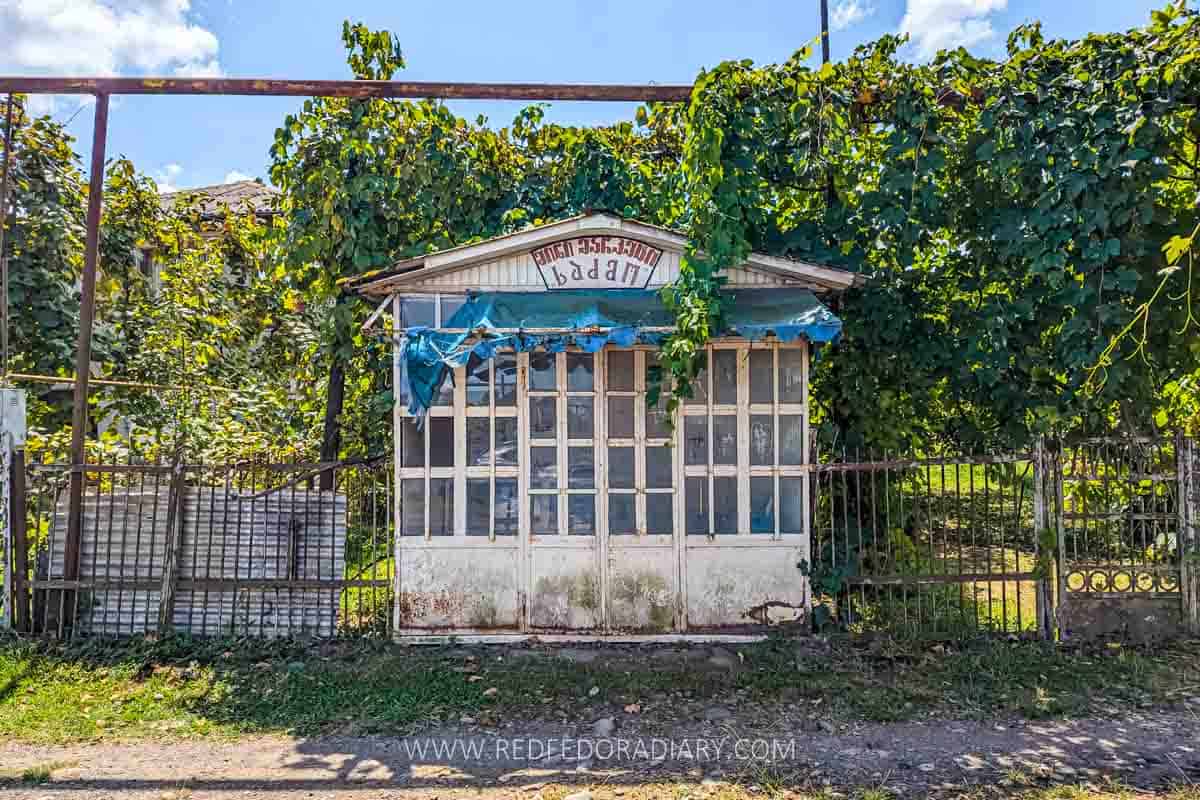
During the Soviet era, Ozurgeti municipality became one of the prime areas for Georgian tea production, where tea plantations occupied the region’s 33% agricultural land, had 15 factories, accounted for more than 90% of the income from horticulture, and provided 23% to the entire country’s tea production. Read my deep dive into Georgian tea history – how it started, developed, collapsed, and emerged.
Today, it is a busy yet quiet center of Guria, with many things to do to keep you busy for a few days. The municipality still produces tea, citrus, corn, and hazelnut, but not in Soviet quantities. In 2018, Ozurgeti City Hall launched Tea Route, similar to the Wine Route across the country, to help local small and independent entrepreneurs.
Ozurgeti travel tips
When planning a trip to Ozurgeti, knowing a few essential tips for a smooth experience is good. First, remember that while Ozurgeti is a relatively small town and easy to walk through, some of the sights listed here are best enjoyed by car (use LocalRent if you need to rent it). Cash is still preferred, especially in small shops and bazaars. All the museums I’ve been to are free of charge.
For a more detailed explanation of when to visit Ozurgeti, how to get there, and Ozurgeti hotels and guesthouses, click on the titles below.
things to do in Ozurgeti map
For a more comfortable way of exploring the city, here is the Google Maps list of everything to do in Ozurgeti to save and use whenever you need it. You will not need the data to access the spots if you download the area for offline use.
18 Things to do in Ozurgeti city
Basing yourself in Ozurgeti is ideal for those without a car. The city is very walkable, and most of the sights listed here are concentrated in the center. To enjoy tea tastings at various farms and for short trips nearby, you can hire a taxi or ask your host for help.
Start with a coffee at the Ozurgeti city
Ozurgeti city center is concentrated around Platanus Garden and features a few notable landmarks in a piazza-like setting.
On our last visit, we got coffee at Coffee In Ozurgeti, a small place serving good coffee, sandwiches, and cakes, and sat down at their outdoor tables to get the feel of the city and people-watch before starting the exploration.
Explore the collection at the Art Gallery
Contemporary Fine Arts Center, named after Merab Berdzenishvili, a famous sculptor and artist, is next to the Coffee in Ozurgeti.
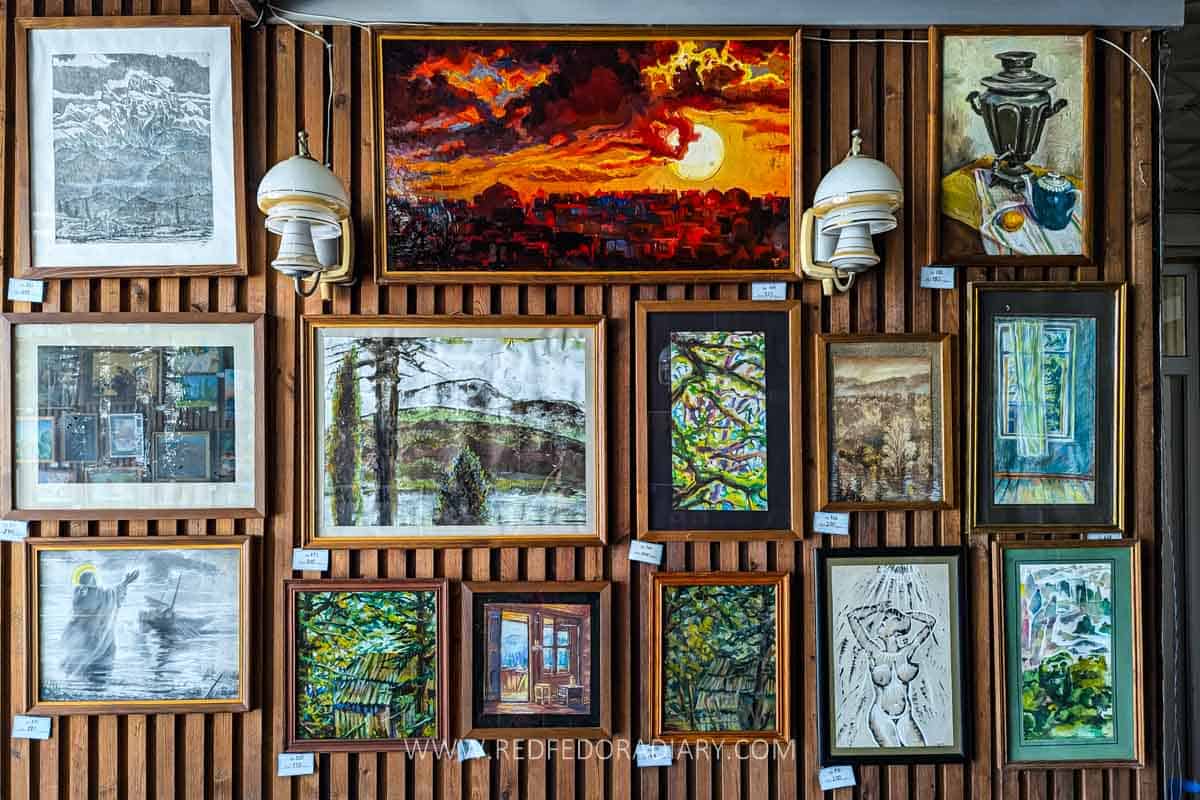
Opened in 1989, the first exhibition showcased the works of Ozurgeti artists. Now, it displays paintings of Gurian and other international artists in its permanent, average-sized rooms and occasionally hosts other temporary exhibitions.
- Opening hours: Mon-Fri from 10 am to 5 pm; closed on weekends. Lunch break from 1 pm to 2 pm.
- Entrance fee: FREE. 1 GEL during the temporary exhibition.
Admire the Soviet architectural gem of Drama Theater
The most impressive building of Ozurgeti center is the State Drama Theater. Opened in 1962, the theater resembles an ancient Greek building with high raised arches and bas-relief decoration on top. I especially loved the various faces expressing different emotions used to decorate the columns once you step inside the arches.

Based on its dimensions, it is one of the largest buildings in Georgia after the Philharmonic in Tbilisi and can accommodate 750 people in its arena and two gallery rows.
The theater is quite active and hosts theatrical festivals. From 2016 to 2020, it underwent extensive renovation.
Unfortunately, I haven’t been inside, but seeing photos online, its ceiling reminds me of the Culture House in the village of Shroma (see below).
Learn more about the region at its history museum
Behind the Public Service Hall, a relatively new and modern building is now home to an Ozurgeti History Museum and a Folklore Center.
The bas-relied decorations on the exterior next to the entrance doors are quite impressive and worth stopping by, even if you are not into the museum.
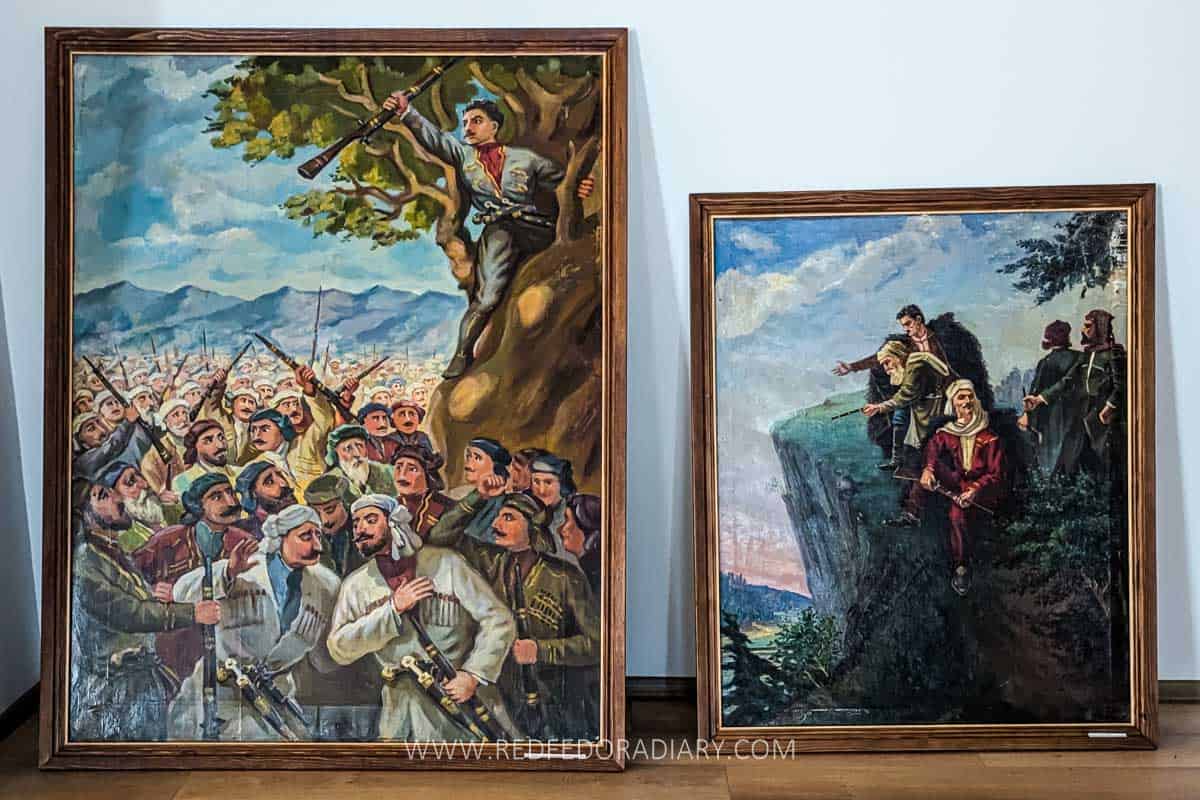
I haven’t visited the Folklore Center, but I went to the museum, where a lovely lady showed me around and explained the artifacts exhibited. Sadly, most items are placed on the floor and leaning on the walls as they wait for the government funds to hang them and have proper displays. Because of that, some very iconic and valuable items are stored.
The museum showcases beautiful paintings of Gurian uprisings, memorabilia of the Gurieli family, clay coffins (I don’t think I’ve seen them elsewhere), and a few ethnographic items, to name a few.
Generally, the museum has a collection of more than 6000 items from the 9th millennium BC to the current times. Some iconic objects include burial ground stocks from the Iron Age, ancient silver and golden items, archival books, etc.
- Opening hours: daily from 10 am to 6 pm; lunch break from 1 pm to 2 pm.
- Entrance fee: FREE
Try to notice Gurieli’s Bath
When researching my trip, I stumbled upon news that a two-floor Byzantine bathhouse was found in Ozurgeti Center, and I was immediately excited to see it. However, when I arrived, I passed it twice before realizing I was standing at the right spot.

Located right at the side of the main street, next to the museum and police station buildings, Gurieli’s Bath excavation spot has no sign and is a tiny open hole. Looking at some old photos online, you could have noticed a brick arch, but today, it’s covered in soil, with only traces of the walls visible on the surface.
This bathhouse is considered part of the Guriali family’s residency that once occupied the territory of the modern-day Public Service Hall, police station, the Platanus Garden, and museum.
Walk through the Platanus Garden
On the territory of today’s Platanus Garden, the Gurieli family had a garden. The last ruler of Guria, Mamia III Gurieli, was open-minded and encouraged every novelty and initiative so that his principality had a European feel. That’s why he invited a Scottish landscaper, Jacob Marr (his family house, turned into a museum, is in Dablatsikhe, Chokhatauri), in 1822 to decorate the Gurieli family garden with exotic plants and trees not native to Guria.

During the Soviet times, in the 1930s, the government started to put roads within the garden, dividing it into three small recreational areas named after Stalin, Lenin, and Beria. When the city was renamed Makharadze in 1934, the government planted plane trees in the garden, and the locals started to call it a Platanus Garden unofficially.
The park’s current state is based on this layout and still features century-old trees, benches, walking paths, and Assumption Cathedral in the middle. At the park entrance from the Drama Theater side, there’s a bust of Benia Chkhikvishvili, a politician involved in the Social Democratic movement in the early 20th century and the president of the de facto Gurian Republic.
Marvel at Gurieli’s Palace
At the end of the park, towards 9 April Street, stands a beautiful building in dirty yellow color with crosses on top and another church next to it.

This used to be the Gurieli Palace, a residence of the ruler dynasty of Guria, constructed in the 1860s, making it the oldest building in Ozurgeti.
From 1974 to 1991, Gurieli Palace was home to the Ozurgeti History Museum. Today, it belongs to the Orthodox Church, is a bishop’s residence, and is closed to visitors.
Learn how Georgia’s legendary historian preserved the nation’s historical wealth
Ekvtime Takaishvili, a renowned archaeologist and historian, was born in the village of Likhauri, just 7 km from Ozurgeti. As one of Georgia’s most important public figures, Takaishvili made significant contributions to academia and politics.
From 1889 to 1920, he held archeological excavations in 21 different places, studied and recorded more than 300 above-the-ground buildings (churches and castles), collected many epigraphic materials, and saved many Georgian manuscripts.

He was a founding member of Tbilisi State University (TSU) and lectured on Georgian history at several prestigious institutions in Tbilisi. Between 1907 and 1910, he led archaeological expeditions in the historical region of Tao-Klarjeti, now part of Turkey, uncovering valuable pieces of Georgia’s ancient past.
Following the February Revolution of 1917, Takaishvili entered the political arena, co-founding the National Democratic Party of Georgia, and was elected Deputy Chairman of the Constituent Assembly of the Democratic Republic of Georgia from 1919 to 1921.
After Georgia lost independence to Soviet rule, Takaishvili joined many of his colleagues in exile, fleeing to France and taking Georgia’s national treasury to preserve our cultural heritage.
Despite facing severe financial difficulties and pressure from European museums to sell portions of the priceless collection, Takaishvili never parted with a single piece. He safeguarded it until 1933 when the League of Nations recognized the Soviet Union following the closure of the Georgian embassy in Paris and the treasury becoming part of the French state.
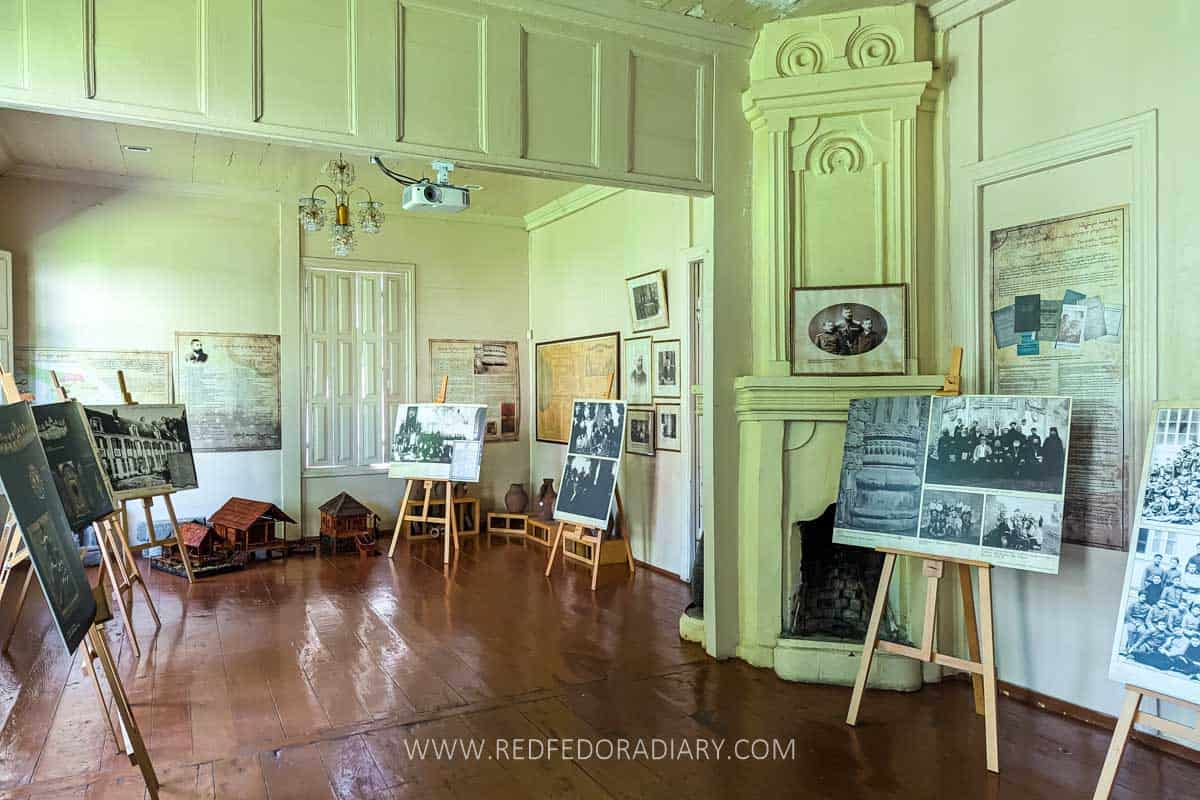
Only after World War II could Takaishvili return Georgia’s national treasury to its homeland and travel with it himself.
Ekvtime Takaishvili Archaeological Museum-Reserve in Ozurgeti city center in a typical Oda house represents the start of his career, his works regarding this treasury and tells its story in poster displays. You can read in detail what kind of treasure he managed to take in several dozen boxes and what hardships he endured to keep the safe.
In 2002, the Georgian Orthodox Church recognized him as a saint and called him ‘a man of God’. He is buried in Tbilisi, at Mtatsminda Panthenon. His house in Likhauri was turned into a museum, displaying his personal memorabilia, notebooks, and works.
Interesting info: The chateau in Leuville, with 4.5-hectare of land, which once was home to the Georgian government in exile, including Takaishvili and Noe Zhordania (the Head of the Government of Georgia in its brief independence timeframe), was transferred to the Georgian state in 2016.
I read that the government plans to have an extensive renovation for ten years, but I couldn’t find any recent news about the process. The latest I could find is from 2023, stating that the chateau’s ground floor will have a Georgian-French Memorial Museum. Please let me know in the comments below if you know any details.
- Opening hours: Tue-Sun from 10 am to 6 pm; closed on Mondays. Lunch break from 1 pm to 2 pm.
- Entrance fee: FREE
Hunt down Ozurgeti’s gorgeous street art
One of my favorite things to do in Ozurget was to scout for street art. I love big, meaningful, and beautiful murals, especially in quiet towns like Ozurgeti. After successful street art pieces in Tbilisi, Kutaisi, and Batumi, Ozurgeti has a handful of street art painted by local and international artists in the past three years under the Niko Movement project (except for one).
Each mural’s theme is obviously Guria, its life and culture. Most murals are within walking distance of each other and are placed around the city center, except for four. The locations are in my Ozurgeti Google Maps list provided above. One particular mural is in Chanieti village, which I haven’t seen myself but is still on the list.
Gurian Sun by Sali Nikolaishvili
This mural in the city center behind the Drama Theater represents the emotions and energy of the artist about the Guria region. She tried to show the environment, feelings, and mood Guria is famous for among Georgians.
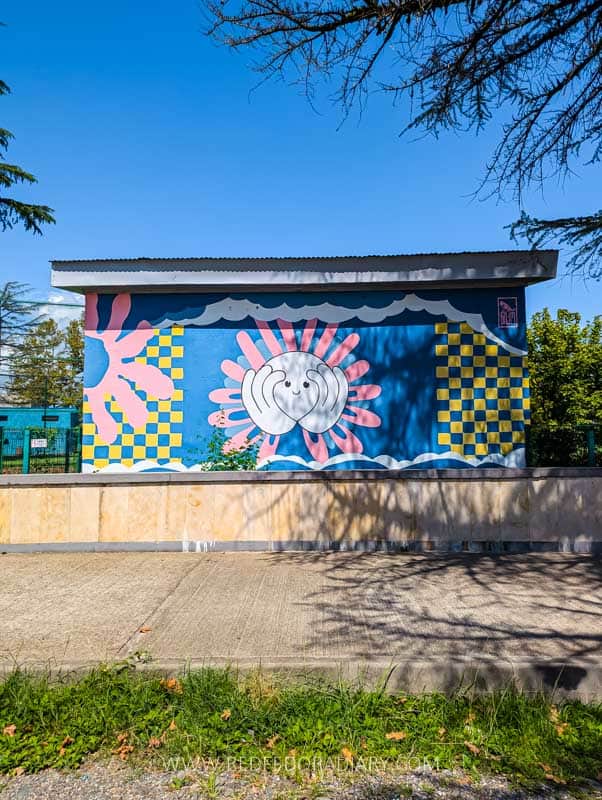
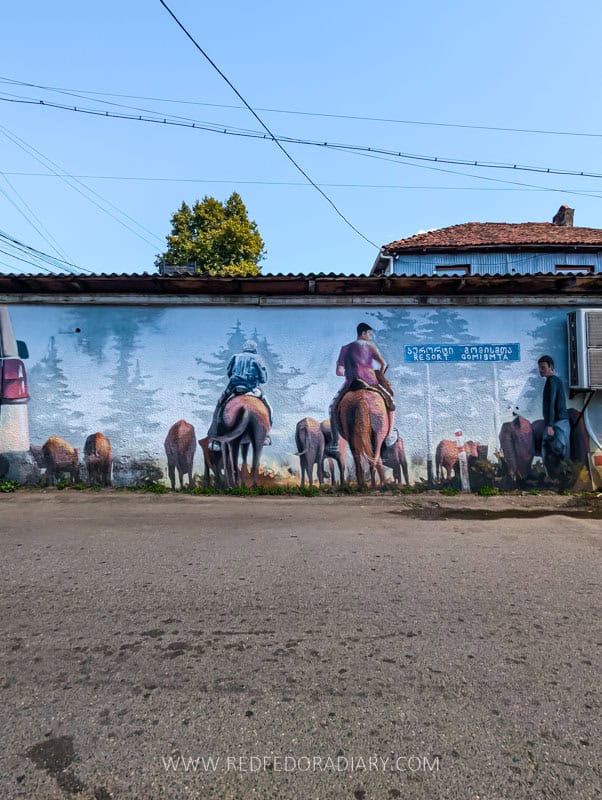
Resort Gomistma by Giorgi Kalandarishvili
Famous Georgian artist who has done many murals in Tbilisi, created this piece in 2021 and was one of the first waves of the Niko project in Ozurgeti. The street art shows a group of horseman on their way to Gomistma or Gomi Mountain.
Gurian Horse Riders by Giorgi Kalandarishvili
Another great piece, and my favorite in Ozurgeti, is devoted to the iconic and famous Gurian horseman who participated in Buffalo Bill’s Wild West Shows in Europe and the USA for almost 30 years since 1892.
The mural depicts two riders, Giorgi and Karaman Kalandarishvilis, who were champions of the show with their skills and tricks.
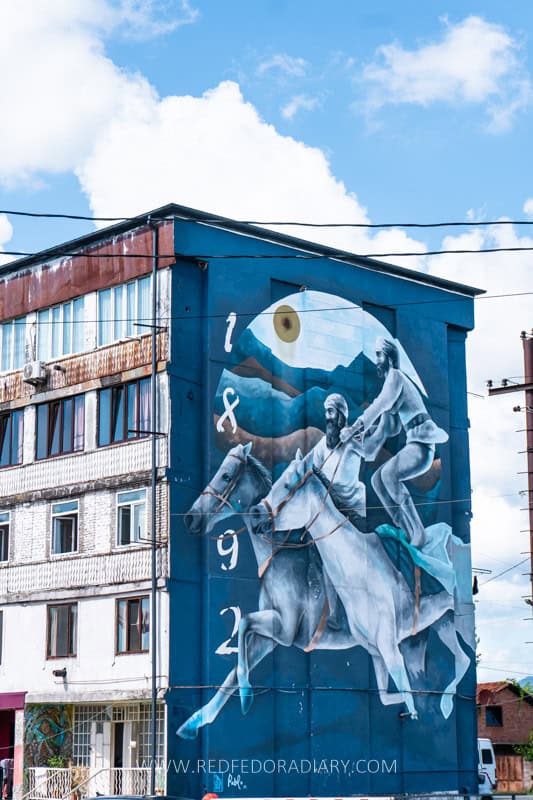
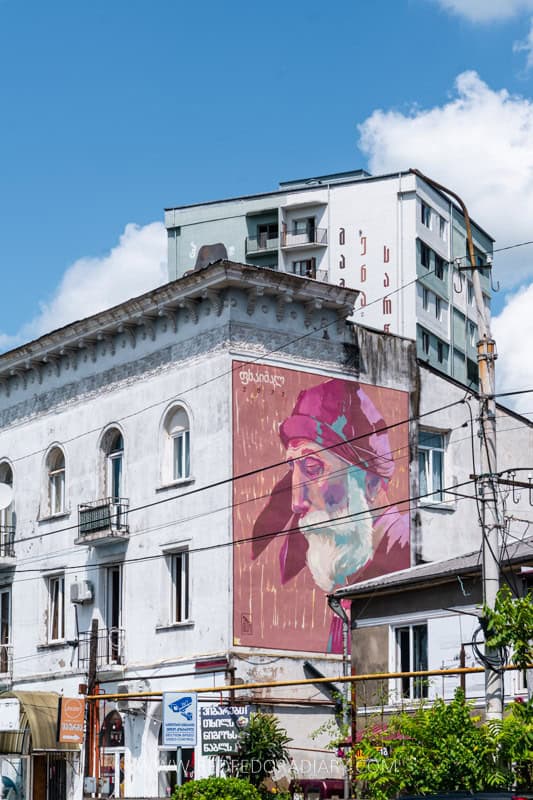
Abdali by Primal
Near Hero Square, the mural shows a Gurian man in traditional attire, Chokha, and a Gurian head scarf/hat.
On his second visit to Georgia, the French artist decided to use Georgian folklore in his work and devote this to the country he fell in love with and met many like-minded friends.
Fun fact: the word ‘Abdali’ in Gurian means ‘a fool’ and is very common in daily communication. Depending on the context, it can be both offensive and playful.
Dancers by Arkane
Another gorgeous mural by a French artist near the Ozurgeti Bus Station showcases two women in old traditional clothes he got inspiration from Georgian choreography. He uses only two tones and an engraving method for his wall.
Girl by Sasha Korban
I am a huge fan of Sasha’s murals, and he has done pretty stunning ones in Tbilisi and Kutaisi, so looking at this one in Ozurgeti was a treat.
Unfortunately, I couldn’t find any information or the inspiration behind the mural; neither Sasha nor Niko’s project have descriptions on their pages. However, looking at Sasha’s Instagram page, I think it’s part of a short series he did in a very similar style. If you know any details, please comment below and let me know.


It’s a Georgian way by Azram
Slovenian artists created this mural in 2023 on the outskirts of Ozurgeti, on David Aghmashenebeli Street. The friendly smiles of the locals inspired Azram and shows the ability to deal with the most difficult situations with a positive attitude. It’s Georgian way, or ეგრე ვიცით, ქართველებმა! – Egre vitsit Karvelebma.
Astronaut Girl by Tamoonz
Along with Gurian horse riders on the Gomismta mural, Tamoonz’s Astronaut Girl is one of the first murals that Ozurgeti got within Niko 2021.
A few meters from this, there’s another small piece – a collaboration of Tamoonz with Ksyu done in similar bright colors, a similar girl, and colorful bugs.


Men Care Mural
At the corner of Ioane Petritsi and Gabriel Episkoposi streets, you’ll find a mural specifically created for UNFPA’s project Men Care based on the illustration of Tatia Nadereishvili and painted on the wall by Lia Ukleba.
The mural was painted for Father’s Day within the framework of the EU for Gender Equality project.
Tsitsa and Tsindali by Masholand
This mural by a Georgian female artist close to Ozurgeti Train Station showcases her childhood memories in Guria during the summer holidays.

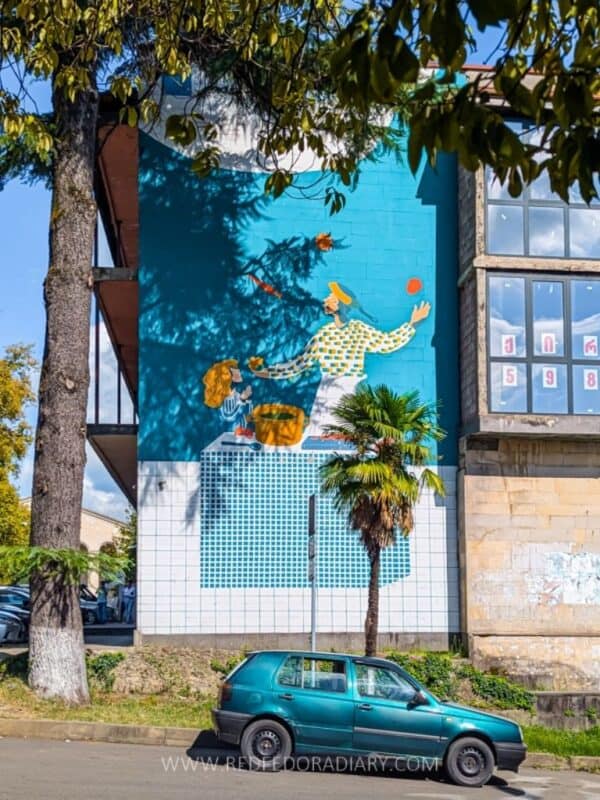
When working on the sketch idea, she could only think of things she remembered from her times spent in the region: kittens (‘tsindali’ in Gurian dialect), big pink and fragrant tomatoes, piles of nuts spread on the balcony for drying, still unripe citrus trees, and the fact that locals called her ‘tsitsa,’ a Gurian word for ‘a girl.’ Therefore, all these memories became this vibrant and colorful mural.
Shop for straw hats and other products
Ozurgeti Farmer’s Market is a labyrinth of outdoor stalls selling fresh veggies, spices, clothes, construction materials, hazelnuts (the prime product of Guria), and various produce made of straws, including wide-brim hats and baskets.
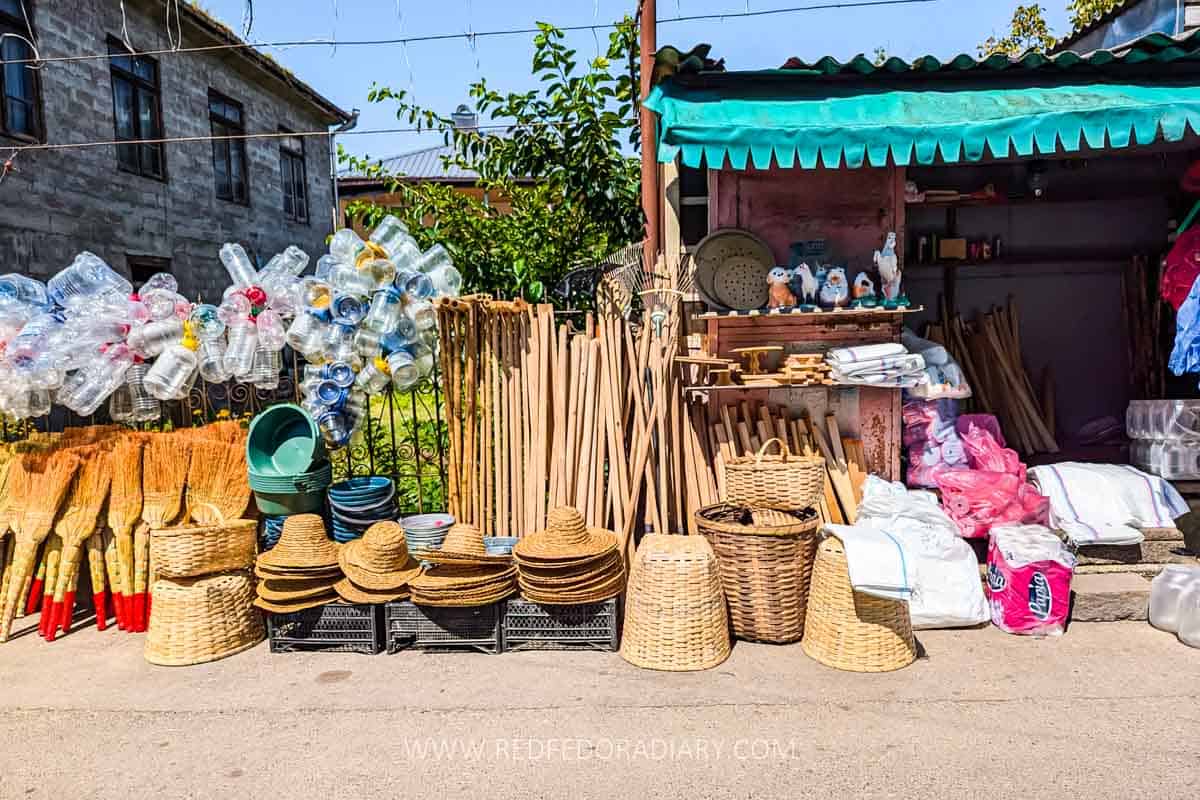
I have four hats hanging on my room’s wall. It makes a cute decoration. On my last visit to Ozurgeti, I was looking for a few different baskets, but I could not find the ones I liked.
Look for Soviet mosaics and other memorabilia
Apart from scouting the street art, another of my favorite things to do in Ozurgeti was to find new mosaics and bas-reliefs from the Soviet era and revisit some to see if they were still there.
The region has many mosaics from the bygone era, signifying the region’s importance in Soviet economics. Most of these mosaics, beautifying buildings, and bus stops are outside Ozurgeti (see the section below for more spots), but two are in the city.

Amirani Sport School at 6 Victor Dolidze Street, close to the Ozurgeti Railway Station, has one of the well-preserved mosaics showing a group of athletes – gymnasts, football, and volleyball players in action.
Outside the city center, there’s an Askanit clay processing factory at the end of Chokhatauri Street. The factory’s territory has been fenced, and on my last visit, I saw part of it being used for something judging from the new roof, wall cover, and blue tarpaulins.

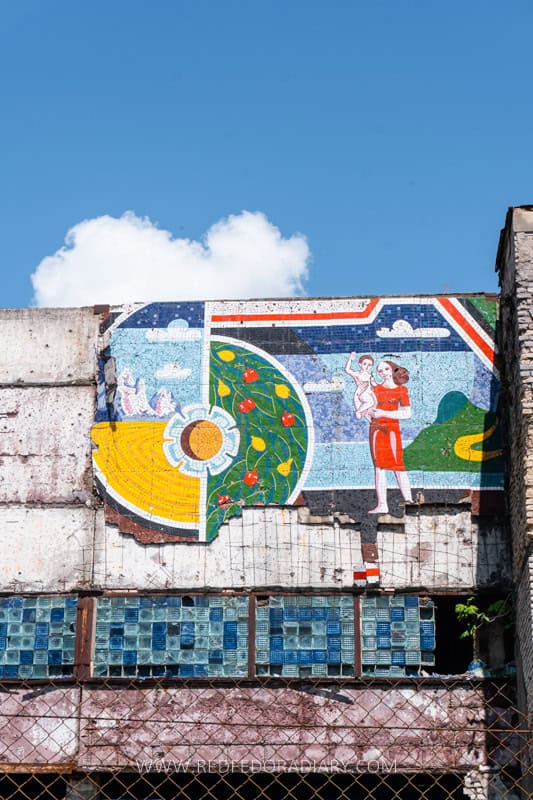
A partially abandoned factory sadly has most parts of its panoramic mosaic missing – only two sections are intact – the industrial part, with men working in the factories, and the agricultural part, with women holding a toddler. I would love to see the entire panel and how these two parts connect. The name in Cyrillic is also noticeable.
Two impressive bas-reliefs are on both sides of the walls at the History Museum and Folklore Center entrance. They should be telling a story, but I couldn’t find any information on it. I believe one should be connected to Medea and the Argonauts, but I may be wrong. Please comment below if you have any details.
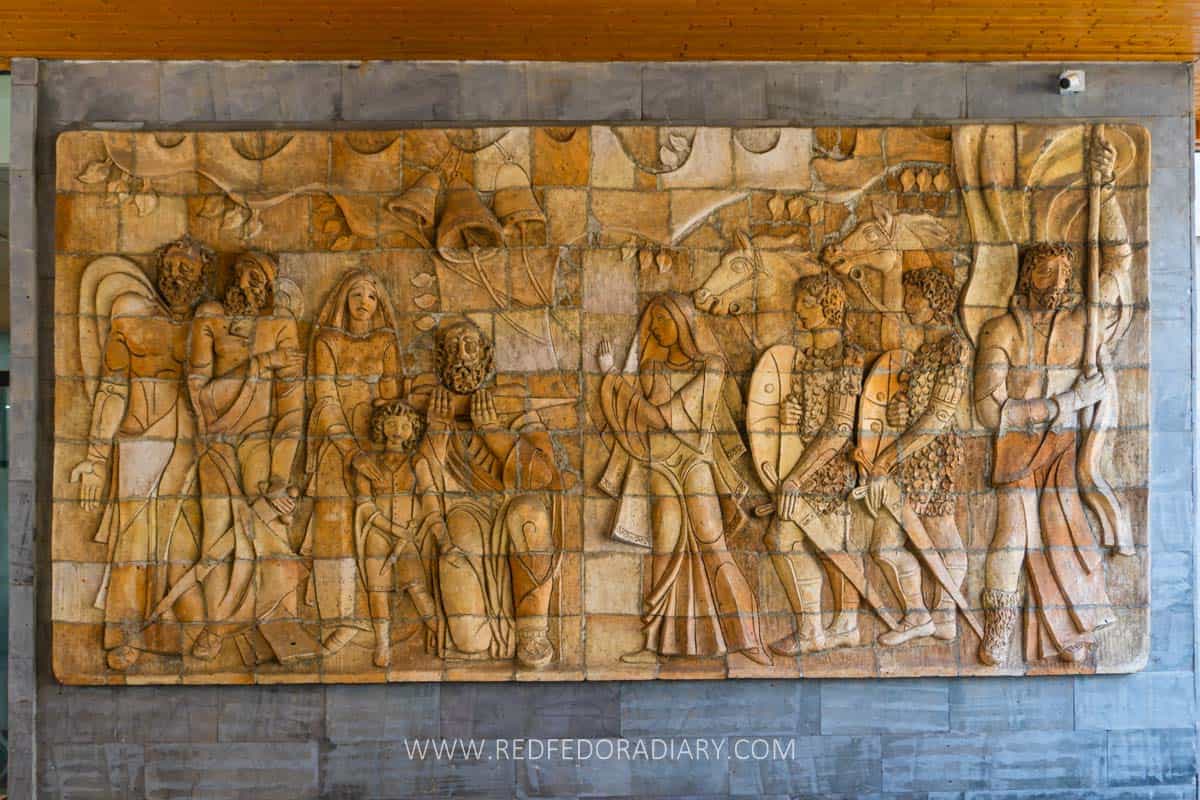
The Second World War memorial at the Hero’s Square is quite impressive. On the almost opposite side of the monument, I found another remarkable art of bronze color plastered on the wall (pictured below) showcasing five Guria agricultural and folk fields – tea, citrus, and wine cultivation, Gurian folk singing, and horsemanship.
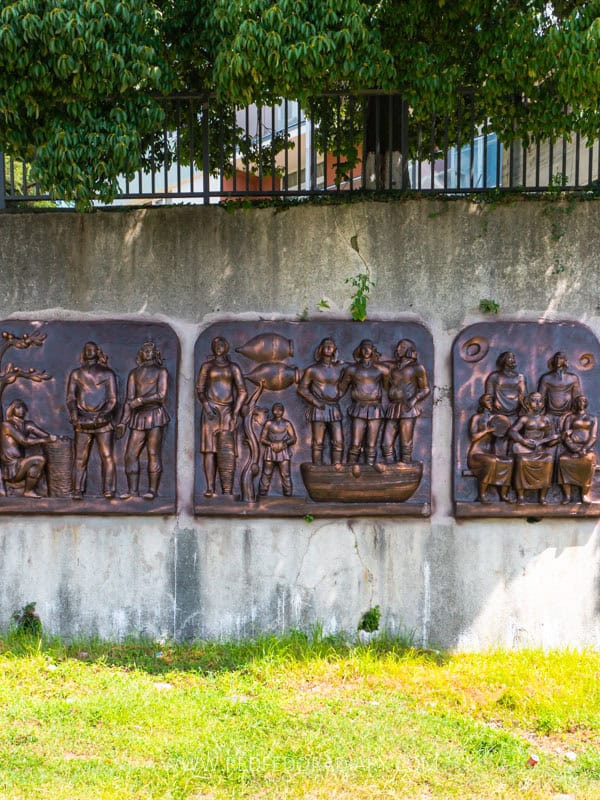
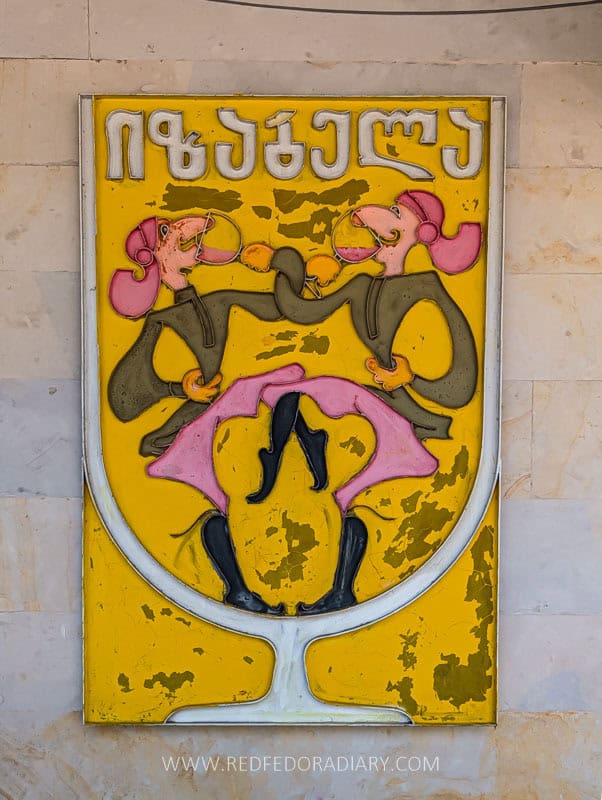
Close to the Ekvitme Takaishvili Museum and below the Soviet apartment blocks, you’ll find a dried-up fountain topped with a mermaid statue overlooking the fountain. Walk behind the statue on a plaza-like space to find a canteen that has the cutest sign of Izabela (a.k.a Adesa) wine.
Peek inside the Ozurgeti Railway Station
While you won’t find it super luxurious, the inside of the train station is impressive with its design, beautifully shaped windows, arches, and columns. I believe it was more remarkable back in the day.
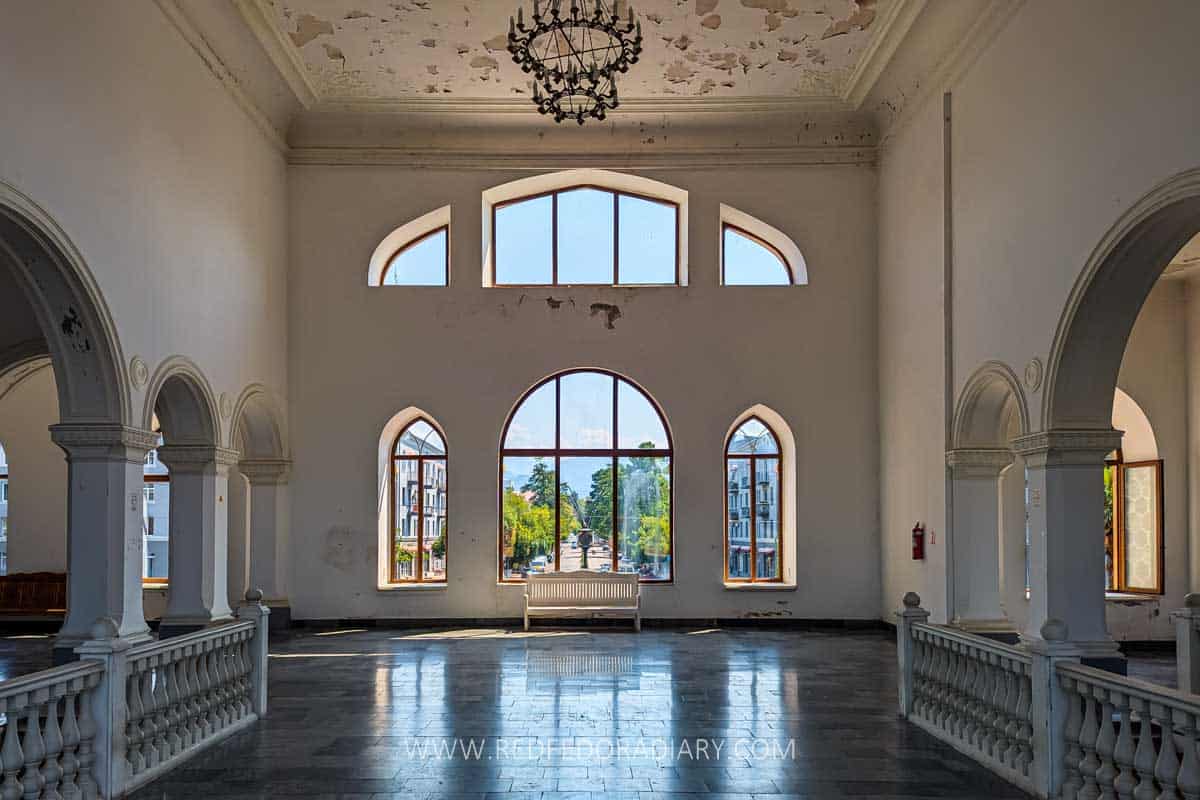
The station’s construction began in 1925 after the government needed to link Ozurgeti with Natanebi, a nearby village, and it took five years to build it completely. Today, only part of its original appearance remains.
The ground floor of the building has furniture shops, and you can access them from a side staircase leading to the tracks and the back of the station.
Things to do in Ozurgeti Municipality
For venturing out of the city, you’d need a car or a transfer organized by a company (tea farms, in this case) or your accommodation host. Intercity transportation in rural areas is limited to a few schedules during the day, and they mostly go to the villages, not the sights outlined here. However, you can still inquire at Ozurgeti Central Bus Station for a marshrutka that can drop you close to the sight.
Visit Anaseuli tea plantations
As Guria was a prime hub for tea production, tea fields are still scattered across the region. Anaseuli, located 5km from Ozurgeti center, is the best place to see the remnants of the once flourishing Soviet-era industry.
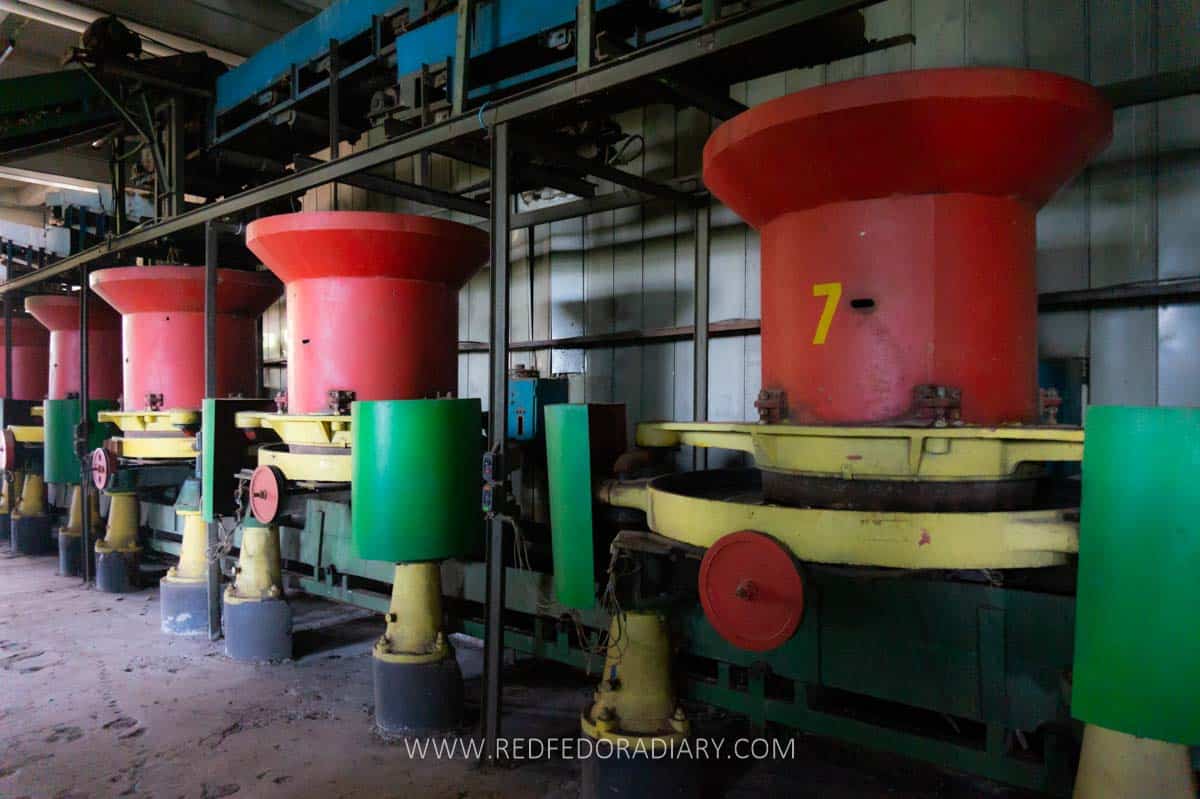
Most facilities, including the scientific research institute and processing factories, are now abandoned. The tea bushes are overgrown. However, out of dozens of facilities, one – Anaseuli Tea Factory – still produces tea and vodka under the Anaseuli brand. A few years back, I had an opportunity to walk through its tea processing factory and see its Soviet-era machinery still in use. If you want to visit, contact them in advance.
On Google Maps, you can find plantations numbered from 1 to 13. The best way of exploring them is to have a car. Tea and Subtropical Corps Institute within the Anaseuli complex, which once contributed immensely to tea research, is abandoned. Several beautiful mosaics are still there, but not in great shape. Hazelnut crops have replaced some of the tea fields.
To understand the area’s importance, I encourage you to learn more about the Georgian tea industry through my detailed guide.
Do a Georgian tea-tasting
While in the area, it’s a shame not to do a tea tasting following the Tea Road. Thanks to small artisanal tea farmers, the industry is making a comeback, slowly but steadily.
In 2018, the Ozurgeti Municipality launched the Tea Road project to encourage tea growers, revive the sector, and bring tourists to learn more about the production.
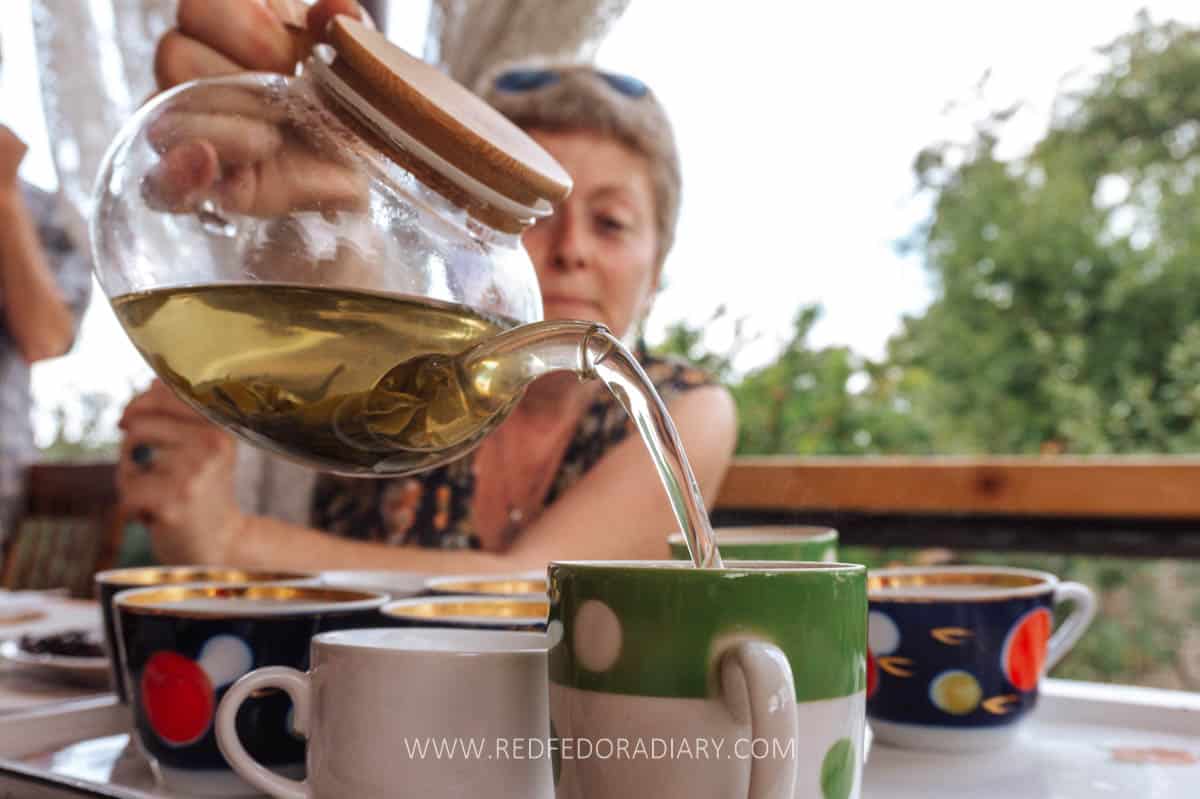
One of the field pioneers is Shota Bitadze, who founded the Georgian Organic Tea Producers Association and has a tiny museum shop in Tbilisi I like to frequent to get some tasty herbal mixes.
Besides the Tea Road, which includes four enterprises, a few other places offer tea-tasting, a tour of the plantations, and Gurian meals for lunch. I have been only to two for now. I had a full package tour with a home-cooked regional lunch at Komli and a tour only at Teni Tea. Both of them are part of the Tea Road, along with the Anaseuli Tea Factory. Taba Tea House & Garden is another place closer to Ozurgeti city. You need to book visits via phone on their Facebook pages.

As a side note, if you happen to be in Kutaisi, check out Renegade Tea Estate, which revived the old Soviet tea farm very close to the city.
Komli in Tsitelmta, 6 km from Ozurgeti, was my first tea farm visit and introduced me to Georgian tea’s turbulent and interesting history. As a local, I knew little about the industry before the visit. Lika Megreladze, our host, told us stories of her family being involved in the tea industry for several decades and has a few rows of tea bushes in her garden.

We had a fascinating tea tour, where Lika explained how she cultivates and processes the tea. What sets her apart is that she hand-rolls the leaves instead of using the machinery. She also walked us through the premises of her home, featuring a bamboo forest, a small stream in the backyard, and vast barrels converted into a tiny room.
Besides the tea tour, tasting, and delicious lunch, you can spend a night in that barrel or room inside the family home. They also produce their Chkhaveri Gurian wine and offer wine tastings. Check their website for more information; book a few days in advance. They can also help with the transfer if needed.
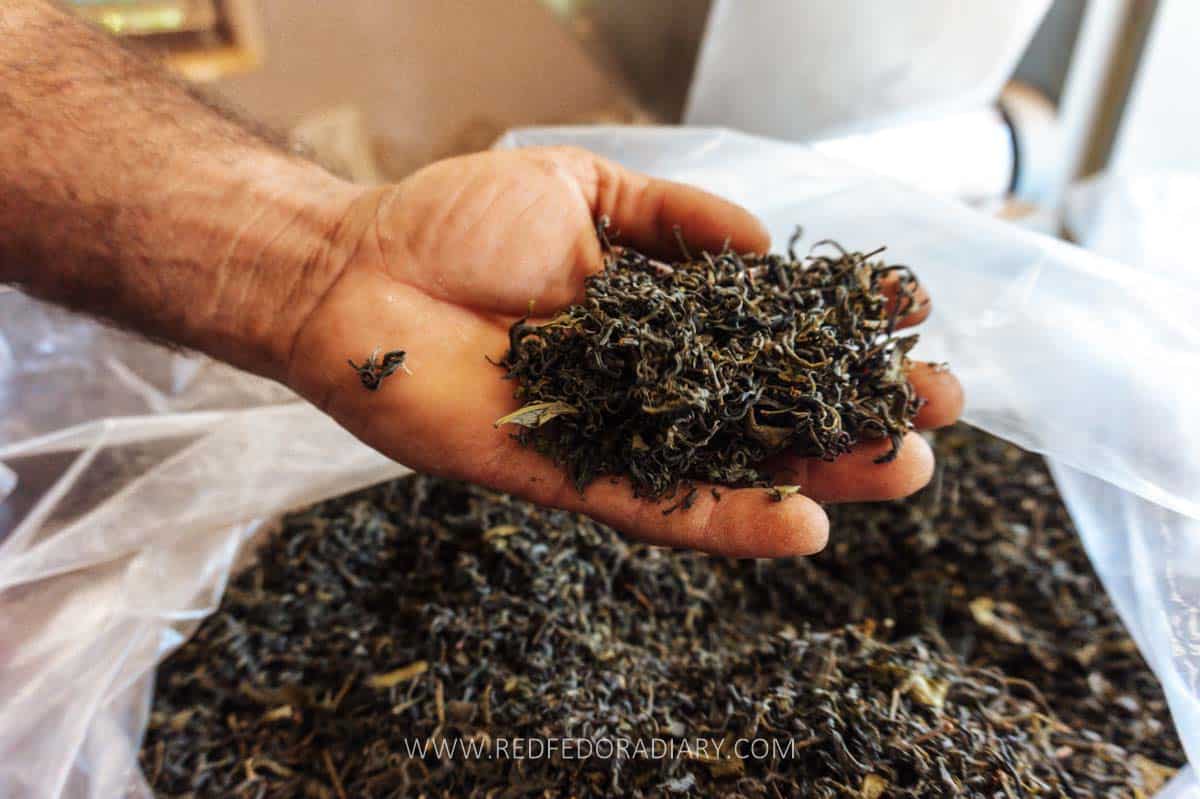
Teni Tea in Kveda Bakhvi, 12 km from Ozurgeti, owned by Dato Teniashvili, one of the pioneers for reviving tea production in the region and the first member of Bitatdze’s Georgian Organic Tea Producers Association, is the restored old Soviet plantation.
During my visit, I only had a tour of the plantation and a walk-through of the production and processing units, where I had a detailed explanation of the entire cycle. I didn’t have a tea tasting then as it was an informational visit, but you can contact them on Facebook or by phone and arrange a tasting along with the lunch.
Take a trip to Shemokmedi Monastery and its oddly beautiful cemetery
Unlike many Georgians and foreigners, I am not much into Orthodox Churches and rarely visit. Therefore, I seldom include them in my guides. That said, if you find a church in my guides – it means one thing – I truly recommend a visit.
Making only an 8 km detour from Ozurgeti, Shemokmedi is an important religious and historical place for the region. Constructed in the 15th century as the seat of one of the three bishops of the Principality of Guria (the other two being Jumati and Khino), it also served as the burial ground of the ruling Gurieli Family.

The monastery kept many church treasures and extensive collections of items from other Georgian religious sites, but many didn’t survive the 19th-century robberies, and those that did are now on display in the museums.
The viewpoint from the parking space offers beautiful views of the village, which is better than the one from the monastery, in my opinion. The path to the monastery follows through an oddly beautiful cemetery with small mausoleums and lavishly decorated graveyards.
One aspect I have noticed here that I haven’t seen elsewhere is that these small mausoleums also have small stone pictures of the deceased on their walls. I assume to identify them and not walk in someone else’s grave (?!). Unfortunately, even though we were the only ones on our visit, I still felt shy about taking too many photos of the cemetery.

The monastery grounds are open, but the church itself was closed, so we couldn’t get inside to see its frescos. Instead, we walked around it, looking at several dozen more graveyards within its courtyard.
We drove to Shemokmedi Monastery, but when driving through, I noticed a green city bus running the Ozurgeti-Shemokmedi route. Unfortunately, I couldn’t stop to ask more details.
Enjoy the sunset above the clouds on Gomismta
If Chokhatauri has Bakhmaro, Ozurgeti has Gomismta (Gomi Mountain) – a summer mountain resort 2,100-2,755 meters above sea level. Winters here are cold, while summers are moderately cool.
Surrounded by coniferous and spruce forests from the southwest and alpine meadows from the northeast, Gomismta is an escape for Ozurgeti residents in summer, much like Bakhmaro in Chokhatauri. Wooden cabins and A-frame cottages dot the slopes of Gomi Mountain.

With a newly asphalted road, it takes around 60 minutes to get to the resort from the city. Remember that the road is only accessible in summer, from mid-June to late September. Unfortunately, no public transport exists, so you need a car or a taxi transfer.
Gomismta’s appeal lies in its surreal natural wonder of clouds and fog concentrating in the valleys, creating an image of a sun slowly falling into the ‘sea of clouds’ at sunset. This is highly weather-dependent. Sadly, on my visit to Gomismta, we experience a complete fog cover of the surroundings and no ‘sea of clouds.’ As we were not staying overnight, it was a bummer but still a beautiful sight.
The resort has basic amenities, and most people go camping with all the necessary equipment and food or rent a few cabins. Alternatively, you can stay in Gomi village and drive to the top of the mountain for the sunset. But be careful driving back in the dark.
Trace the Soviet architectural splendor in nearby villages
One of my favorite things to do in Ozurgeti and Guria, in general, is to find some stunning Soviet architectural buildings in villages. This is one of the reasons I started appreciating it as an adult, and being a travel content creator in my own country, I started looking at things from a different angle.
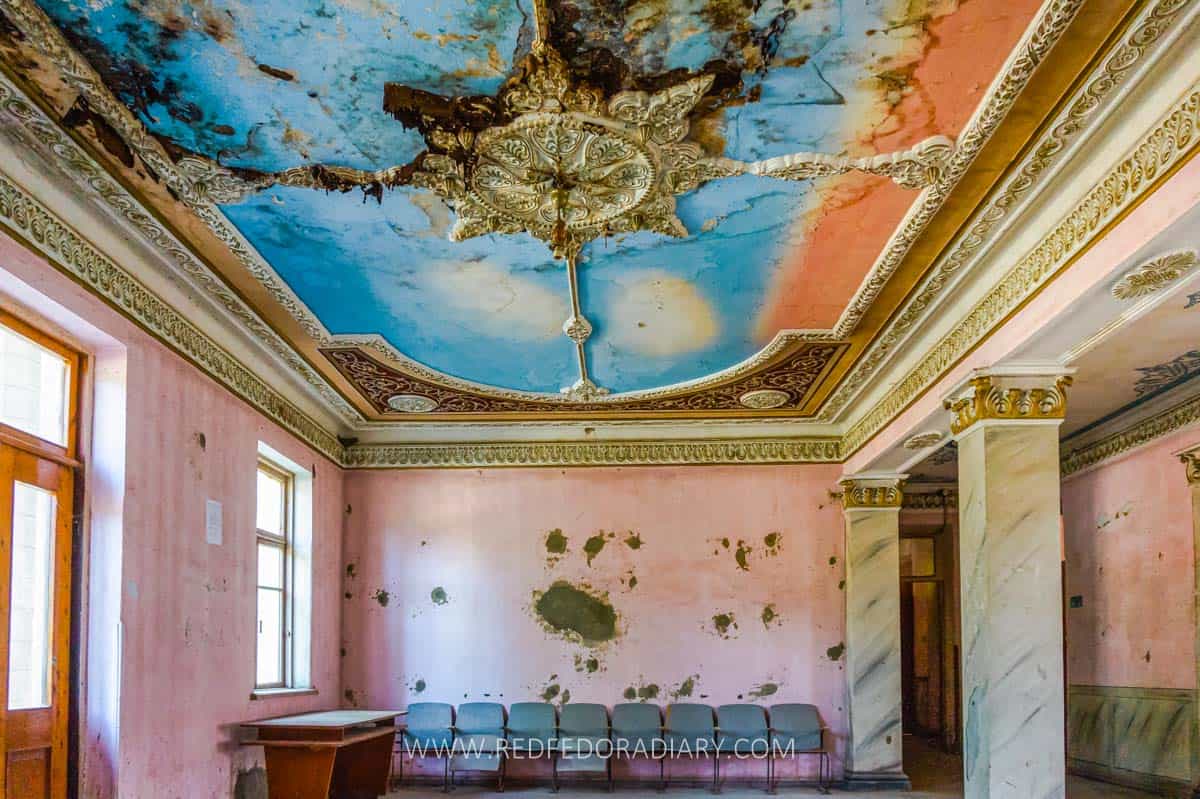
The region has plenty of fascinating Soviet Culture Houses and administrative buildings. While I haven’t visited everything yet, I compiled a few of the absolute favorites I tracked down over several visits to Ozurgeti.
During the Soviet rule, villages like Shroma and Natanebi thrived due to the high production of tea, citrus, and corn. Shroma primarily grew tea; by 1927, the plantations amounted to 100 hectares, and in 1935 to 1,000 hectares.

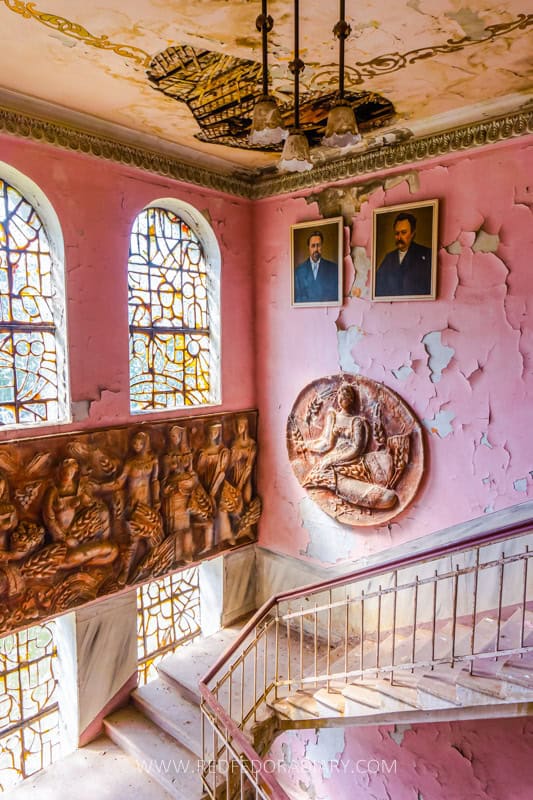
Being the wealthiest villages, they needed appropriate, lavish, and splendid buildings. In 1956, an Administrative Building for Collective Farming was built in Shroma, followed by one of the most beautiful Culture Houses I’ve seen right next to it. You’ll find a beautiful mosaic wall near the Administrative Building and a World War II memorial with a tank that fought in the war.
Both buildings were in pretty bad shape when we visited a few years back. But you’d make out the lavish decoration nonetheless. The Administrative Building hallways have intricate decorations, friezes, glass mosaics, bas-reliefs, and ceiling decorations.

The Culture House, which once could accommodate 800 people, was abandoned for decades and was in worse condition than the next-door building. However, I’ve heard it is currently under construction and closed to visitors. I can’t wait to go back once it’s fully refurbished.
Village Natanebi was the wealthiest in the municipality. Natanebi Lenin Collective Farm owned 382 hectares of tea, 380 hectares of corn, and 115 hectares of citrus plantations.
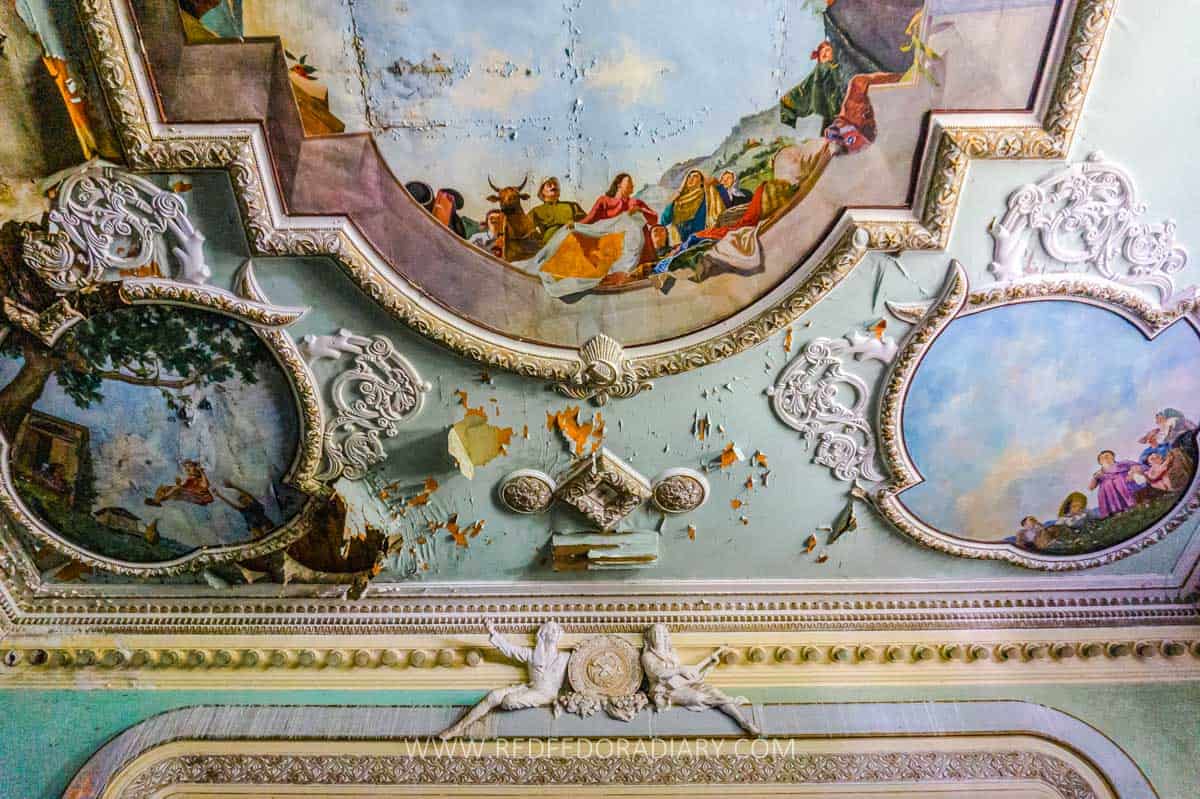
In 1953, the Administrative Building of Collective Farming was built in Natatnebi, followed by Culture House in the mid-50s. It also had a hospital, citrus packing factory, tea processing factory, several schools, a candlenut drying facility, and a library.
The Administrative Building, located in the village of Shava’s main road (the exact pin is in my Google Maps list, is very impressive with its high-rise columns, intricate balconies, and Soviet symbolism in blue-gold color domes.
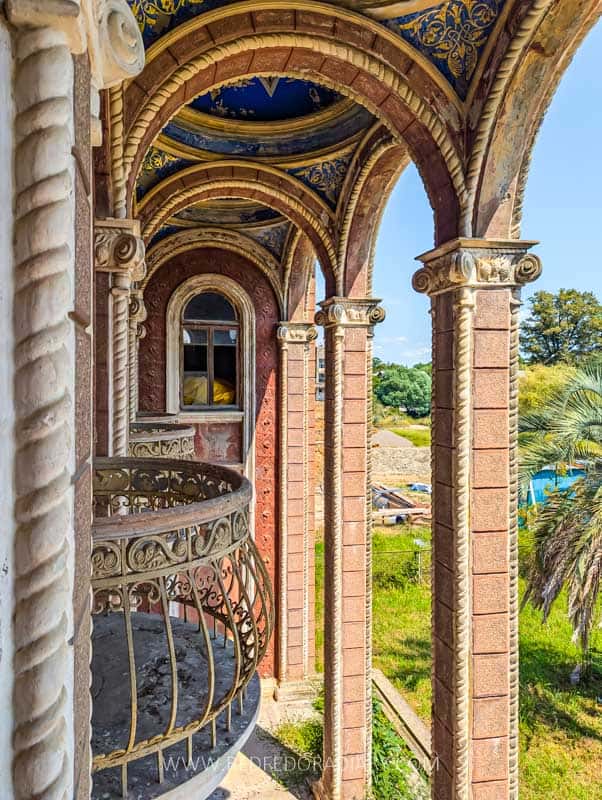

During our visit, the door was open, and we talked. Even though we heard people talking in one of the rooms, no one came out. At the entrance hallway, you’ll see the World War II memorial in honor of the heroes with black and white pictures, presumably of the village residents who fought in the war.
The rest of the building rooms (at least those open) are abandoned and ruined. However, it’s not as impressive inside as Shroma’s Administrative Building. However, I adored the elongated dome ceiling on the second floor’s main hallway.
Seek out Soviet mosaics and bus stops
Apart from those lavish Soviet architectural buildings, Guria is also home to many mosaics adorning bus stops, kindergartens, Culture Houses, former shopping centers, WWII memorials, etc. They mostly have similar themes, mainly concentrated on crops the region was producing – tea, citrus, and corn, as well as legends and folklore traditions.
Besides the decorative wall near Shroma’s Administrative Building (sadly, I lost the photo with the entire archive I stored on my external drive), there are a handful of other spots to seek out for. All the exact locations are included in my Google Maps list.

My favorite bus stop is in Gurianta on the main highway to Shroma and Natanebi village. The bus stop was renovated a few years back and has a fresh look, while the mosaic has a tea theme with three females dressed in simple yet colorful clothes. The date and the author are unknown.
On this main highway, there’s another bus stop in Meria village with more flora and fauna theme, a rarity for Guria. Sadly, similar to the Shroma mosaic, I don’t have a photo of it anymore. Both the author and the date are also unknown for this one.
Before we pulled up at the Natanebi’s Administrative Building, we stopped at the kindergarten, a few meters from it. The mosaic decoration covering a giant building wall done in the late 1980’s is almost gone, but to my surprise, one of the rooms inside has a well-preserved mosaic of an underwater world from floor to ceiling, a stained glass massive wall, two pools, and a hanging ship!

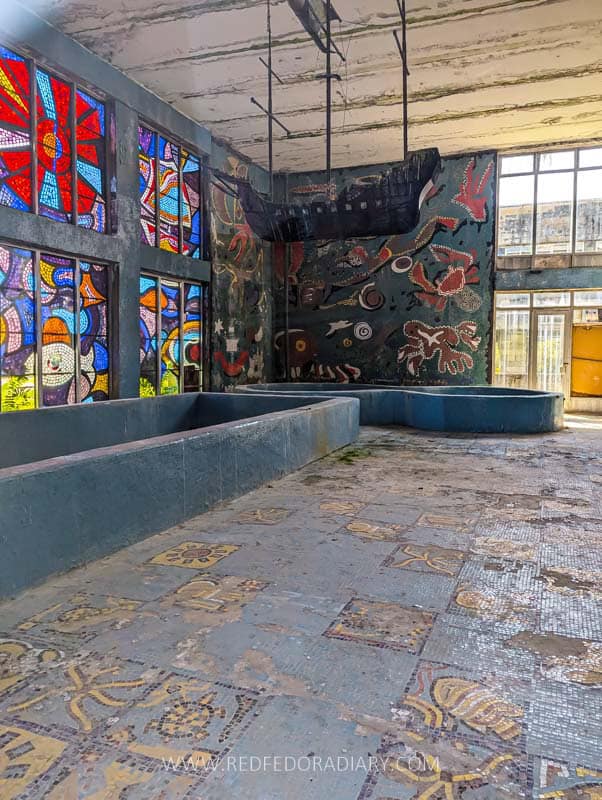
I am unsure if the kindergarten is active; it looked abandoned, judging from its courtyard’s highly overgrown and low-maintained grass. We didn’t get to go inside as everything was locked, and I took the pictures through a glass door.
From here, we continued to Kvemo Natanebi village to see a decorative wall of the former shopping center. Different from the above-shown mosaics, this one’s a bit scary if you ask me at first glance. But if you look closer, you’ll make out Georgia’s entire story and legends.

The mosaic wall, made out of much bigger pieces than usual, features the ship of Jason and the Argonauts, the football championship cup, Oda houses, labor workers, a citrus tree, a pegasus, various faces in different dimensions, a quote from Russian writer Leo Tolstoy and many more objects surrounding the central female figure. The more I looked at it, the more items I’d see.
My Guria regional guide has a few other mosaics from Lanchkhuti and Chokhatauri municipalities.

გამარჯობა, მადლობა სრულყოფილი გზამკვლევისთვის
ორი მცირე შესწორება, რომელიც ვფიქრობ გამოსადეგი იქნება
1. პირველი საბჭოთა პერიოდის მოზაიკა არის სასპორტო სკოლის (და არა მოსწავლე ახალგაზრდობის ცენტრის) კედელზე
2. ქალაქში ჩასვლა ასევე შესაძლებელია თბილისი-ბათუმის მატარებლის გამოყენებით, ურეკის სადგურიდან ოზურგეთამდე დადის მუნიციპალური ტრანსპორტი, რომელიც მორგებულია მატარებლის განრიგს, ურეკიდან ოზურგეთში ჩადის დაახლოებით ნახევარ საათში, ფასი 2 ლარი, გადახდა შესაძლებელია ადგილობრივი სამგზავრო ან საქ. ბანკის ბარათით
მადლობა გიორგი,
რუკაზე რატომღაც ეგ შენობა მოსწავლე ახალგაზრდობის ცენტრად არის მონიშნული. როგორც ტექსტში მიწერია, მახსოვდა რომ სკოლაზე იყო. ჩავასწორებ აუცილებლად. ურეკი-ოზურგეთის ტრანსპორტი არ ვიცოდი, მადლობა! TBCს ბარათით, ნაღდი ფულით, ან სხვა საერთაშორისო ბარათით ხომ არ შეილება გადახდა, როგორც ქუთაისში, ბათუმში, და თბილისში?